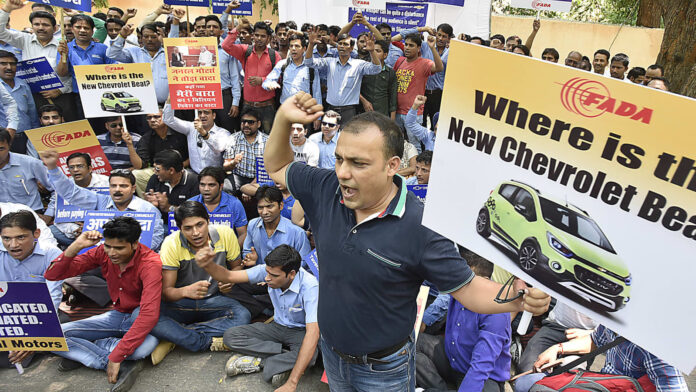
General Motors’ exit from India illustrates the profound challenges foreign companies face in the country, revealing why India remains a treacherous place for investment. The American automaker stopped selling cars in 2017 and announced the closure of its last plant in 2020, yet it did not fully exit until 2024. The drawn-out process exposed a business environment riddled with cumbersome regulations, unpredictable labor laws, and bureaucratic red tape.
GM’s attempt to leave India was met with relentless obstacles almost immediately. In 2021, approximately 1,100 employees at the Pune plant refused what GM considered a generous severance package, filing lawsuits alleging labor violations. Indian law mandates compensation equivalent to a full year’s salary, in addition to company-designated severance, and courts can issue inconsistent rulings, prolonging disputes. The initial court ruling forced GM to continue paying half of employees’ salaries during the legal process, despite its appeal. Prajot Gaonkar, former head of employee relations at GM India, described the ordeal as “crazy, out of this world.”
The difficulties GM faced were compounded by India’s notoriously slow bureaucratic processes. Government data shows it takes an average of 4.3 years to close a factory in India, compared with one year in Singapore, 15 months in Germany, and one to two years in the United Kingdom. Politicians and regulators often appear more concerned with protecting workers than enabling business, while legal systems can interpret labor laws inconsistently, leaving companies trapped in prolonged disputes. Shoumitro Chatterjee, an international economics expert at Johns Hopkins University, notes that such “exit barriers” act as hidden costs, discouraging foreign investment and stunting the manufacturing sector.
GM’s financial woes in India were exacerbated by these structural hurdles. Over 20 years, the company lost more than $1 billion. While the sale of its Gujarat plant in 2017 went smoothly, the sale of the Pune plant dragged on for four years, derailed by the government’s refusal to approve a transaction with Chinese automaker Great Wall Motors. Even after halting production, Maharashtra’s labor authorities initially refused GM’s closure request, insisting the company absorb losses. Unions escalated the dispute through petitions and public protests, including a hunger strike, before courts finally ruled in GM’s favor in 2023 and 2024.
These issues were not merely procedural—they scared off potential buyers and illustrated the risk for foreign investors. GM had offered a generous severance package, attempted to have employees waive their right to sue, and even tried transferring staff to other plants. Yet Indian labor laws, combined with union intransigence and political interference, made a straightforward exit nearly impossible. Hyundai ultimately acquired the Pune plant, but only after a prolonged saga that delayed the company’s strategic decisions and tied up capital for years.
By contrast, other countries handle plant closures efficiently. Ford’s exit in India still faced delays, but Tata Motors’ acquisition of its Gujarat plant proceeded smoothly because the Indian company agreed to assume all employees. Tamil Nadu authorities publicly supported Ford in legal proceedings, allowing a timely closure and equipment removal. GM had no such support in Maharashtra, showing how uneven regulatory enforcement and political interests make India a risky environment for multinational corporations.
Economists argue that India’s rigid exit barriers contribute to a stagnant manufacturing sector. Only 3% of Indian factories close each year—one of the lowest rates globally—while countries like Vietnam, China, and the United States experience much higher turnover. Approximately 20% of Indian manufacturers exist as “zombie enterprises,” tying up capital without producing goods. GM’s protracted struggle demonstrates that India’s regulatory, labor, and bureaucratic hurdles can cripple business plans, discourage investment, and prevent companies from efficiently reallocating resources.
GM’s experience underscores that doing business in India is far from straightforward. While the country offers a large labor force and consumer market, excessive regulation, unpredictable courts, and hostile labor frameworks make it one of the most challenging environments for foreign companies to operate—or to leave.
Source: Medium, Forbes, USA Today, AutoCar Pro, CNBC



